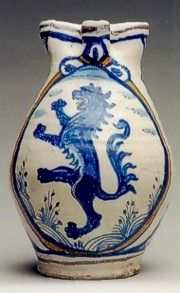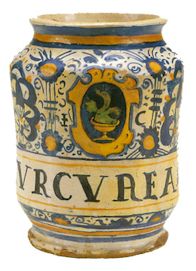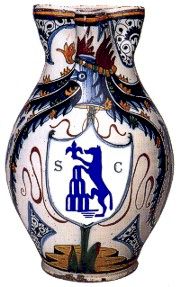|
Montelupo
has undergone a significant revival as a town and as a manufactory of
high-quality painted ceramics during the past ten years. There is a now fine majolica
museum as well as an archaeological museum, and, of course, numerous
workshops and outlets producing and selling hand-painted ceramics in both
traditional and modern styles. The main reason for a visit to Montelupo
is to admire and perhaps buy hand-painted majolica.
In antiquity, the territory of Montelupo, situated between Montalbano and the middle course of the
Arno near where the
river Pesa
flows into the Arno, was already an important crossroads on the communication route between the Florentine area, the Apennines and the Tyrrhenian coast. Its location on the old Roman road that joined Florence and Pisa and the presence of waterways led to the development of numerous manufacturing activities, including ceramics.
Montelupo was probably founded with the construction of a castle at the end of the Early Middle Ages. The Florentine Republic, which took over the territory in 1204, rebuilt and enlarged the original military settlement. In the
14 C (1333-36) a new circle of walls, still
visible in part, was constructed to protect the town that had developed at the foot of the hill on which the
Priory of S. Lorenzo, built in the 13 C, still stands. During the
15 C and 16 C, the ceramics of Montelupo were particularly splendid.
At the end of the 16 C, the Medici built a large villa on the left bank of the Arno in the neighboring locality of the
Ambrogiana. In the
19 C it was turned into a prison asylum, the Ospedale Psichiatrico Giudiziario, but it is now being restored.
The disastrous epidemics of the 17 C that reduced the population of
Italy as a whole had devastating effects on Montelupo, virtually
destroying it as a centre of ceramic production. There was a modest
revival during the second half of the 18 C along with the growth in glass
production. With the construction of the railway line from Florence to
Pisa, there was a revival of ceramic production in nearby Capraia, and
in the early 20 C the centre of production was once more Montelupo.
Every year the town relives its history with a show of its ceramics in a festival that takes place
approximately from 22 to 30 June (be sure to check the dates). The town's inhabitants dress in period costumes to recreate the ancient
atmosphere with minstrels,
merchants and artisans.
Things to see in Montelupo Fiorentino
The Castle of Montelupo
On top of the hill which overlooks Montelupo, “Il castello”
is the remains of the first Florentine military settlement of 1204-06, where there
had previously been a small “castellare”, probably belonging to the counts
Alberti. In the area above, there is the first church in Montelupo, the Old Priory of San Lorenzo, dated 1260, whose present
appearance goes back to the 15 C. Inside there is a series of frescoes by Corso di Buono (1282) and two small Gothic tabernacles painted by Piero di Chellino (The life of San Nicola). The bell tower was built using the existing tower of the keep.
The Palazzo Pretorio
In the village at the foot of the castle you can see the Palazzo
Pretorio, present home of the Ceramic Museum. The coat of arms of the “podestà” who governed the town on behalf of the City of Florence are set into the façade. Inside there are frescoes from the
15 C and remains of the original decorations.
Priory of S. Giovanni Evangelista
The present Priory, originally an almshouse run by Dominican monks, acquired its present appearance in 1796.
It houses some notable works of art: a fresco of 1340-50 which has been detached from the wall, a
14 C wooden cross, a large altar-piece and a painting on wood, both attributed to the
school of Botticelli.
Casa Sinibaldi at Montelupo
This house belonged to the family of Bartolomeo Sinibaldi, known also as “Baccio da Montelupo”, a famous sculptor and architect, friend and colleague of Michelangelo
Buonarroti.
The Frescobaldi Tower of Montelupo
The impressive Torre de’ Frescobaldi was built at the beginning of the
14 C to control the river traffic and guard against the depredations of Castrucci Castracani.
Formerly a mill, the tower was later sold by the Medici to the Frescobaldi family. It now houses the Museo del Vetro Impagliato (raffia covered flasks), a craft which was practiced by the people of Montelupo from the
18 C.
|







